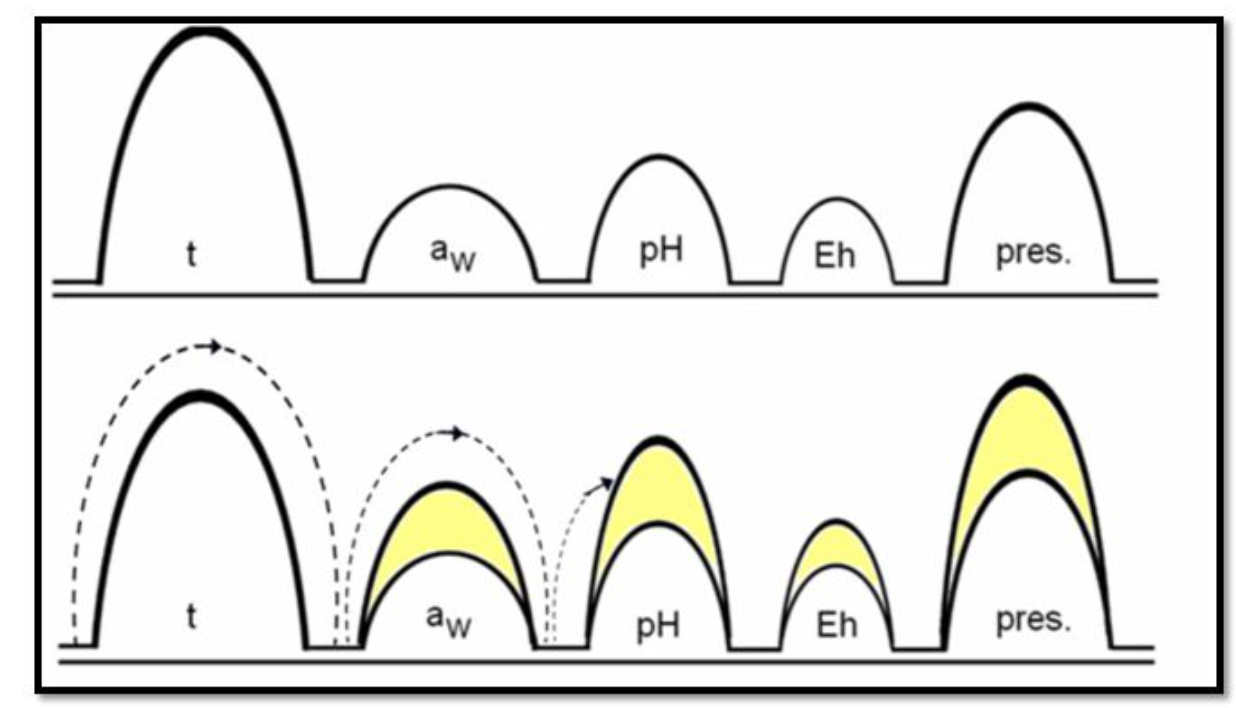W1 L1: Factors affecting growth and survival of microorganisms in food
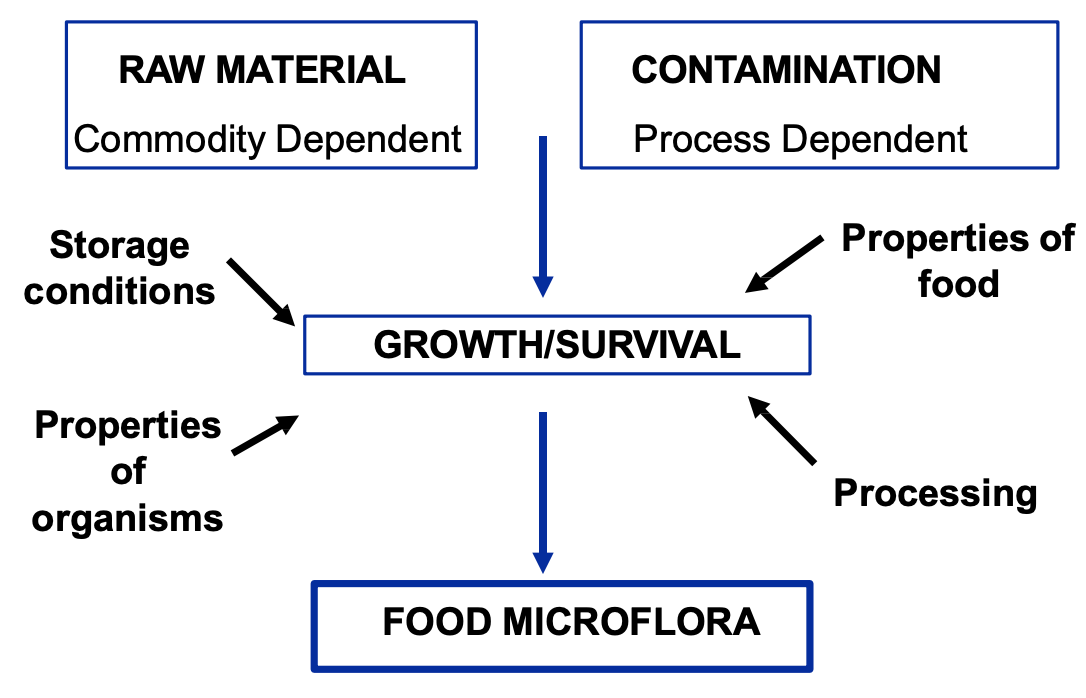
Effects of food microflora:
Food Spoilage (undesirable)
Foodborne Illness (undesirable)
Fermentation (desirable if purposeful)
Manifestations of microbial food spoilage:
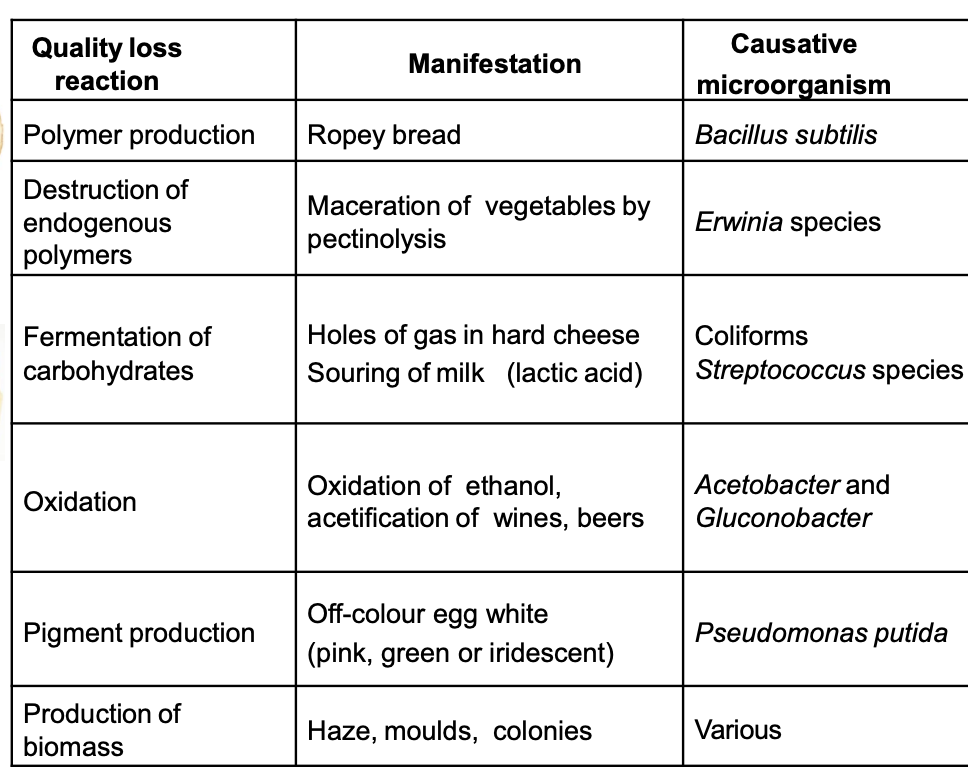
4 Factors affecting microbial growth in food:

Milk spoilage
- Bacteria (Lactobacillus, Lactococcus) grow on milk sugars (lactose)
- Lactic acid is produced/build up → pH ↓ & sour taste
- Acid selects for Δ in the bacterial pop, pH ↓ further & more lactic acid produced until all sugars depleted
- Bacteria start to grow again at the higher pH & use proteins as their major nutrient (no sugars) & then 1º amines are produced
- In very acidic conditions, yeasts & moulds use lactic acid for growth & the pH ↑
Effect of pH on microbial growth:
- pH→ expressing the H ion conc. [H+]
- [H+] is important for living things as the +ve charge alters the charge environ. of other mols. in sol.
- H+ ions can bond to nitrogen or oxygen containing molecules because nitrogen and oxygen have “non-bonding” pairs of electrons
- Acids → substances capable of donating an H+ to a base
- Bases → substances capable of accepting a H+ from an acid
Microbial inhibition by weak organic acid
Undissociated lipophilic acid mols. pass freely via the membrane from an external environment of low → high pH of cytoplasm.
At higher pH, equilibrium shifts in favour of the dissociated molecule, so the acid ionises producing protons which will acidify the cytoplasm.
The cell will try to maintain its internal pH but this slows growth.
If external pH is low and the extracellular acid concentration is high, the cytoplasmic pH drops so that growth is not possible and cell dies
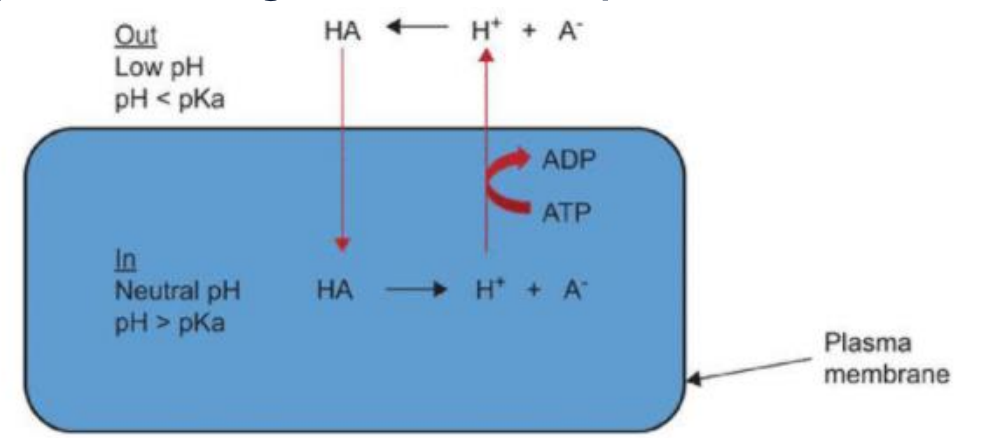
The effect of redox potential (Eh) on microbial growth
- The transfer of H+ ions b/w chemical species determines pH; the transfer of electrons b/w chemical species determines the Eh
- **Redox potential (Eh)**→ tendency of a medium to accept or donate electrons, to oxidise or reduce.
- If it accepts e-s it has a +ve potential → [O] environment
- If it donates e-s it has a -ve potential → [R] environment
- Strong [R] agents have a high electron-transfer potential
- Strong [O] agents have low electron-transfer potential
- Obligate or strict aerobes need O2 and high Eh & will predominate at food surfaces exposed to air or where air is readily available
- Pseudomonas fluorescens, growing at Eh of +100 to +500 mV, & other oxidative Gram- rods produce slime and off-odours at meat surfaces.
- Bacillus subtilis (Eh−100 to +135 mV) produces rope in texture of bread
- Obligate anaerobes tend only to grow at low or negative Eh
- Obligate anaerobes, like clostridia, are of great importance in food microbiology.
- Grown in anaerobic conditions (deep in meat tissues and stews, in vacuum packs and canned foods) causing spoilage or botulism by C. botulinum
The effect of water activity (aw) on microbial growth
Measure of the E status of water (how much is available/not bound)
Water activity (aw) is the vapour pressure of water in equilibrium with the sample (p) ÷ by the vapour pressure of pure H2O at the same temperature (Po)
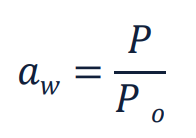
Pure distilled water → aw = 1
Higher aw foods tend to support more microorganisms
Microorganisms differ in their water activity requirements
The effect of temperature on microbial growth
- How a particular microorganism responds to temperature is defined by 3 cardinal points (minimum, optimum, maximum temperatures for growth)
- Different microorganisms respond differently to temperature
- Microbial growth occurs from -8 o C to over 100o C, but:
- some organisms have specific temperature requirements within this range
- food is only stored at certain temperatures
- Mesophiles and psychrotrophs are generally of greatest importance

- Mesophiles, w/ temp optima ~37 °C, - frequently of human or animal origin and inc. many more common foodborne pathogens: Salmonella, St. aureus & Cl. perfringens
- Grow quicker at their optima than psychrotrophs ∴ spoilage of perishable products stored in the mesophilic growth range is more rapid than spoilage under chill conditions.
- Psychrotrophs → found in more diverse range of habitats and consequently are of greater importance in the spoilage of chilled foods.
- Thermophiles → far less important in food microbiology
- thermophilic spore formers such as certain Bacillus and Clostridium species do pose problems in a restricted number of situations
Relative Humidity
- Relative humidity & aw are interrelated → rel. humidity is essentially a measure of the water activity of the gas phase
- Foods w/ a low aw will transfer from the gas phase to the food, when stored in an atmosphere of high relative humidity water
- Microorganisms start to grow they produce H2O as an end product of respiration→ ↑ aw of immediate environment so that micro-organisms requiring high aw can grow & spoil a food which was initially considered to be microbiologically stable
- Storage of fresh fruit & veg needs good control of rel. humidity
- If it is too low then vegetables will lose water and become flaccid
- If it is too high then condensation may occur - spoilage may start
Gaseous Atmosphere
- Oxygen - most important gas in contact with food.
- Inhibitory effect of CO2 on microbial growth - applied in modified-atmosphere packing and at elevated pressures in carbonated mineral waters and soft drinks.
- Moulds & oxidative Gram -ve bacteria→most sensitive to CO2
- Gram +ve bacteria, particularly the lactobacilli→ most resistant
- Yeasts e.g. Brettanomyces spp. show tolerance of high CO2 levels & dominate the spoilage microflora of carbonated beverages
- Growth inhibition→ aerobic conditions > anaerobic and ↑ w/ temperature ↓ due to ↑ CO2 solubility at lower temps
- Some microbes are killed by prolonged exposure to CO2 but its effect is mainly bacteriostatic
The effect of implicit factors on microbial growth
- Implicit factors→ inherent growth properties of the spoilage organisms themselves, how they respond to environment and interact with one another
Growth range
- temperature requirements (see previous table)
- pH requirements (e.g. acidophiles, etc)
- aw (halophiles, xerophiles)
Microbial interaction - how microorganisms influence each other
antagonism (antibiotics, acids)
commensalism (one benefits the other doesn’t)
symbiosis (both partners benefit)
Many moulds can grow perfectly well on fresh foods such as meat, but grow slower than bacteria ∴ out competed
In foods where the faster growing bacteria are inhibited by factors e.g. reduced pH or aw, moulds assume an important role in spoilage
Response of micro-organisms to Δ depends on the physiological state of the organism
Exponential phase cells are almost always killed more easily by heat, low pH or antimicrobials than stationary phase cells
Pre-adaptation will ↓ the damaging effect of adverse conditions
Pre-exposure to a factor ↑ an organism’s subsequent resistance to it
The effect of processing factors on microbial growth
- Processing factors→ the way a food is treated during production and how this influences the presence of microbes
- Slicing/Mincing→ higher exposure to O2 and spread of surface microorganisms to interior of food
- Heat treatments→ higher temperatures will destroy microbes
- Preservatives→ if present will kill or prevent specific microorganisms from growing
- Cooling→ Low temps retards growth
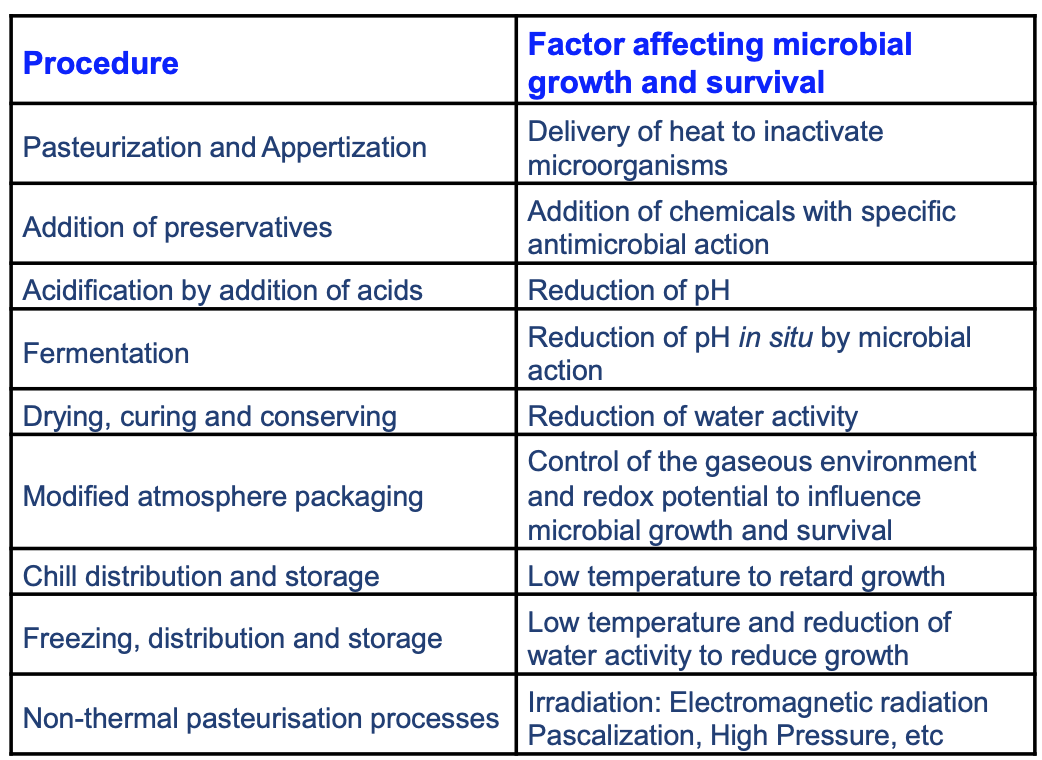
Chemical preservatives
- Preservatives→ substances capable of inhibiting, retarding or arresting the growth of micro-organisms or of any deterioration resulting from their presence or of masking the evidence of any such deterioration
- Don’t include substances like antioxidants or phosphates
- Preservatives may be microbicidal & kill the target organisms or they may be microbiostatic in which case they simply prevent them growing
- Higher levels of an antimicrobial are lethal while lower concs that are generally permitted in foods tend to be microbiostatic
- Chem preservatives are useful only in controlling low levels of contamination & are not a substitute for good hygiene practices
Food preservation by using chemicals:
Nitrite
- Usually in combination with curing: NaCl and nitrite/nitrates, action mediated by NO Nitrites are essential for colour and flavour development in refrigerated treated food Nitrosamines an issue (e.g. bacon and ham)
Sulphites (SO2 , H2S3 , Na2S2O5 )
- Main use in sausages and wine (stops fermentation, antioxidant, preservative)
- Destroy thiamine but promote ascorbate retention
- Allergic reactions in the sensitive (asthma) a problem
Antibiotics
- Must not be used in food if have therapeutic application→ Strict regulation
- Nisin
- Polycyclic antibacterial peptide from Lactococcus lactis
- Used to inhibit spore outgrowth in heat processed products (canned foods, cheeses)
- Natamycin (NatamaxTM)
- From Streptomyces natalensis Antifungal
- Used as a surface preservative for some cheeses and dried sausages
Acids
- Benzoic acid, Sorbic acid, Parabens, Propionic acid
Food preservation by the use of reduced temperature
Below -10°C no microbial growth can occur
Chilled Foods (0-5°C)
- Foods stored above their freezing point
- Changes flora to slow growing psychrotrophs that eventually spoil food
Freezing (-20°C)
- Maintains sensory and nutritional factors
- Does not sterilise food
- Dependent on both temp and aw
Food preservation by Modified Atmosphere Packaging
With specialised packing material and packing machines, the atmosphere around a food can be modified to inhibit microbial growth
- Vacuum Packing→ product (meat) packed in vacuum
- ↓ O2 , ↑ CO2, inhibits aerobes
- creates temporary colour Δ (deoxyhemoglobin)
- used for bulk packing and for some retail meats
- concerns about Listeria monocytogenes, Clostrdium botulinum and Yersinia entercolitica
- **Modified Atmosphere Packing (MAP)**→ tailored atmospheres that change via interaction with food:
- CO2 inhibits aerobic bacteria + moulds Low O2, N2 used to replace O2 to inhibit aerobic spoilage organisms High O2 used to maintain fresh colour in meat, and respiration in fruit/veg
- Controlled Atmosphere Packaging (CAP) → tailored atmospheres which are maintained (steady state)
- used for bulk storage/transport
Hurdle technology
Ensures that pathogens in food products can be eliminated or controlled (safe for consumption food)
By combining more than one approach- pathogens have to overcome these "hurdles" to remain active in the food.
When the E needed for biosynthesis is diverted into maintenance of homeostasis, cell growth is inhibited. When homeostatic E demands exceed the cell's energy-producing capacity→ cell dies
Most foods preserved in this manner
